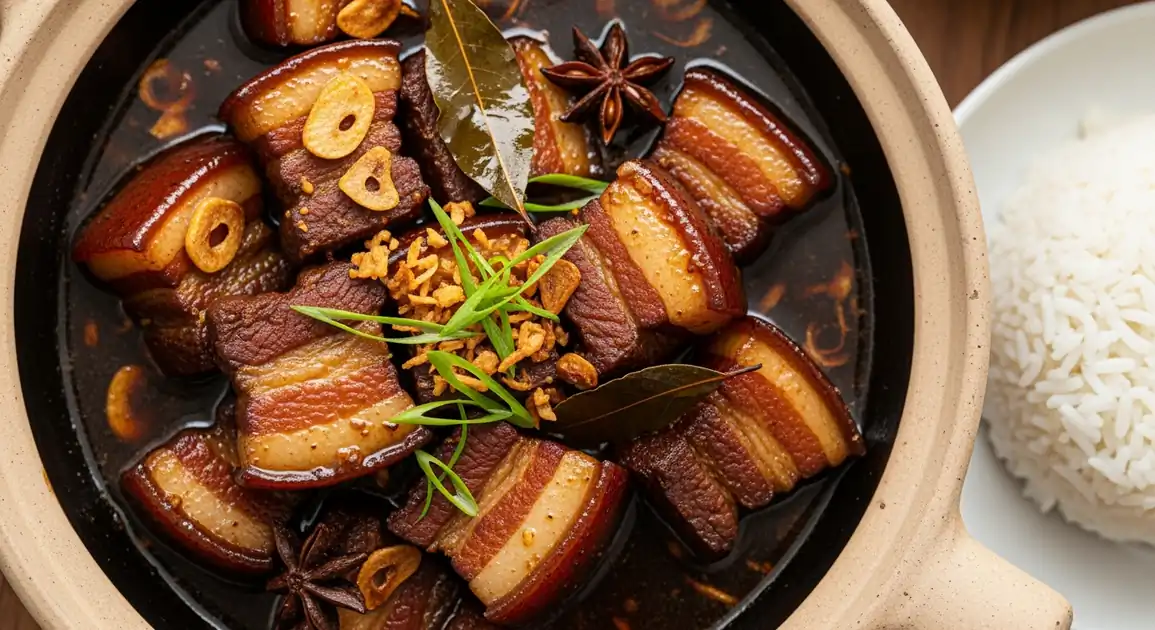Humba Bisaya (Filipino Sweet Braised Pork)
Humba Bisaya

Description
Humba Bisaya is a cherished dish throughout the Philippines but is most authentic in the Visayas region, its place of origin. While variations exist across the archipelago, traditional Humba maintains its identity as a sweet-savory braised pork dish distinct from Adobo. It's commonly found in carinderias (small eateries), restaurants specializing in Filipino cuisine, and homes during celebrations or special gatherings.
Dietary Information
Serving information
Serving style
Typically served on a plate or small bowl with a side of white rice. In carinderias, it's often displayed in trays and dished out per order. Higher-end restaurants might serve it in a clay pot (palayok) for better presentation.
Quick facts
Most carinderias and local eateries serving Humba operate from 7 AM - 8 PM, with peak availability at lunch (11 AM - 1 PM).
Safety Tips
What to Look For
-
Freshly cooked or properly reheated Humba
Humba should be steaming hot when served. Since it's often prepared in advance, proper reheating is essential to kill any bacteria that might have developed during storage.
-
Clean serving conditions
Look for vendors who maintain clean serving areas, use proper utensils, and observe good personal hygiene.
-
Glossy, thick sauce
A properly reduced sauce indicates thorough cooking. It should coat the meat nicely and have a slightly sticky consistency, not be watery or separated.
-
Visible star anise or bay leaves
The presence of these spices indicates authentic preparation methods and attention to traditional ingredients.
What to avoid
-
Lukewarm or room temperature Humba
Pre-cooked meat dishes like Humba should not be held at room temperature for extended periods. Avoid if not properly hot when served.
-
Excessively dry or tough meat
Properly cooked Humba should be tender. Dry or tough meat may indicate old, overcooked, or repeatedly reheated food.
-
Sour smell or taste
While Humba contains vinegar, an overly sour smell or taste can indicate spoilage. Fresh Humba should have a balanced sweet-savory aroma.
-
Very oily, separated sauce
The sauce should be integrated, not showing excessive oil separation, which can indicate improper cooking or storage.
Price information
Price range
Budget tips
- Carinderias (small local eateries) offer the most affordable Humba, typically 60-100 PHP per serving with rice.
- Food courts in malls have mid-range options for around 120-180 PHP.
- Order during lunch hours when many places offer discounted 'lunch specials'.
- Some places offer 'Humba meal' deals that include rice and a small side for better value.
Value indicators
- Generous meat-to-sauce ratio.
- Tender meat that pulls apart easily.
- Complex flavor profile rather than just being sweet.
- Free soup or sabaw served alongside the meal.
- Complimentary rice refill (some carinderias offer this).
Where to Find This Dish
Public Markets
Food stalls inside or adjacent to public markets often serve authentic, affordable Humba.
Wet markets, Talipapa, Market food courts
Morning, Lunch
Filipino Restaurant Clusters
Areas with multiple Filipino restaurants, often finding better quality in those specializing in Visayan cuisine.
Local restaurant rows, Tourism zones
Lunch, Dinner
Town Centers
Carinderias near town plazas or main roads offer homestyle Humba.
Town plaza, Main street, Near churches
Lunch, Early Evening
Vendor Tips
- Ask locals for recommendations on the best Humba in town - 'Asa ang pinakamaayo nga Humba dinhi?'
- Look for places that advertise 'Authentic Bisaya' or 'Lutong Bahay' (home-cooked) specialties.
- Eating earlier in the day ensures fresher Humba, as many places prepare it once in the morning.
How to Order
Regional Variations
-
Humba Bisaya Traditional
(Humba Bisaya Tradisyonal)
The classic version made with pork belly (liempo), featuring the signature sweet-savory sauce with fermented black beans (tausi).
-
Humba Pata
(Humba Pata)
Made with pork hocks instead of belly, offering more skin and collagen. Popular for special occasions due to the impressive presentation.
-
Humba Hamonado
(Humba Hamonado)
A sweeter version often including pineapple chunks or juice, resembling Hamonado dishes but maintaining Humba's key ingredients.
-
Humba with Dried Fruits
(Humba nga may Bunga)
Includes dried fruits like prunes, banana blossoms, or dried apples, adding textural contrast and enhanced sweetness.
-
Humba with Eggs
(Humba nga may Itlog)
Includes whole hard-boiled eggs that absorb the flavorful sauce. Often served for special occasions or fiestas.
-
Humba sa Gata
(Humba sa Gata)
A regional variation that adds coconut milk to the braising liquid, creating a creamier, richer sauce.
Cultural context
History
Humba Bisaya reflects the Chinese influence on Filipino cuisine, especially in the Visayas region. The name derives from the Hokkien Chinese words 'hong' (meaning to braise) and 'bah' (meaning meat). While similar to the Chinese red-braised pork (hong shao rou), Humba evolved distinctly with local ingredients and preferences. It became a staple in Visayan households, particularly in Cebu and Bohol, and is often prepared for special occasions and fiestas. Each family typically has their own version, with recipe variations passed down through generations.
Local significance
Humba represents Visayan culinary heritage and showcases the Chinese influence on Filipino cuisine. It's a dish that embodies the Filipino approach to transforming humble ingredients into rich, flavorful meals through slow cooking and creative seasoning.
Eating customs
- Always eaten with steamed white rice to balance the rich flavor.
- Spooning the sauce over rice is essential to the eating experience.
- Often complemented with something acidic or fresh like atchara (pickled papaya) to cut through the richness.
- Traditionally eaten with a spoon and fork in the Filipino style (pushing food onto the spoon with the fork).